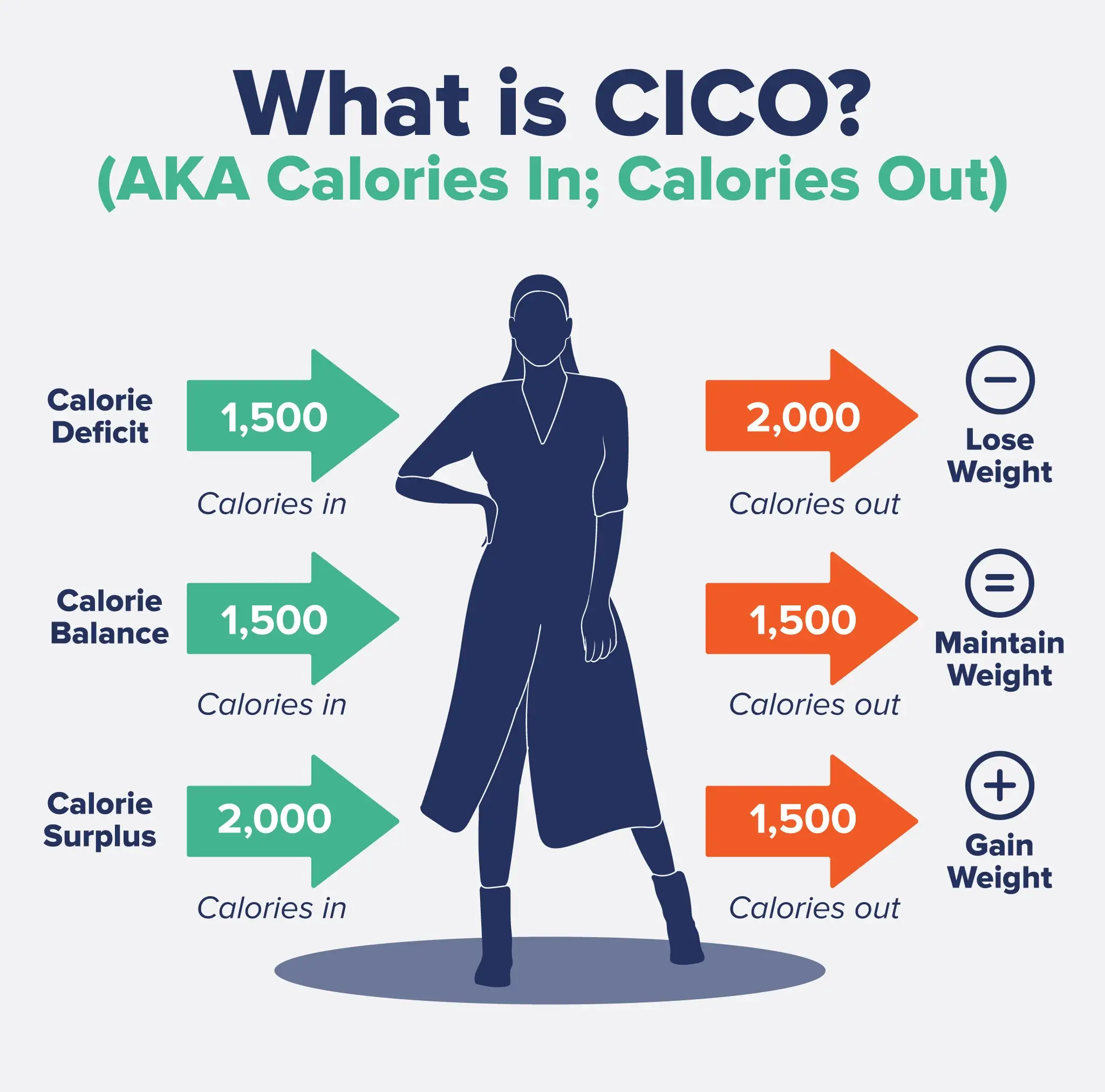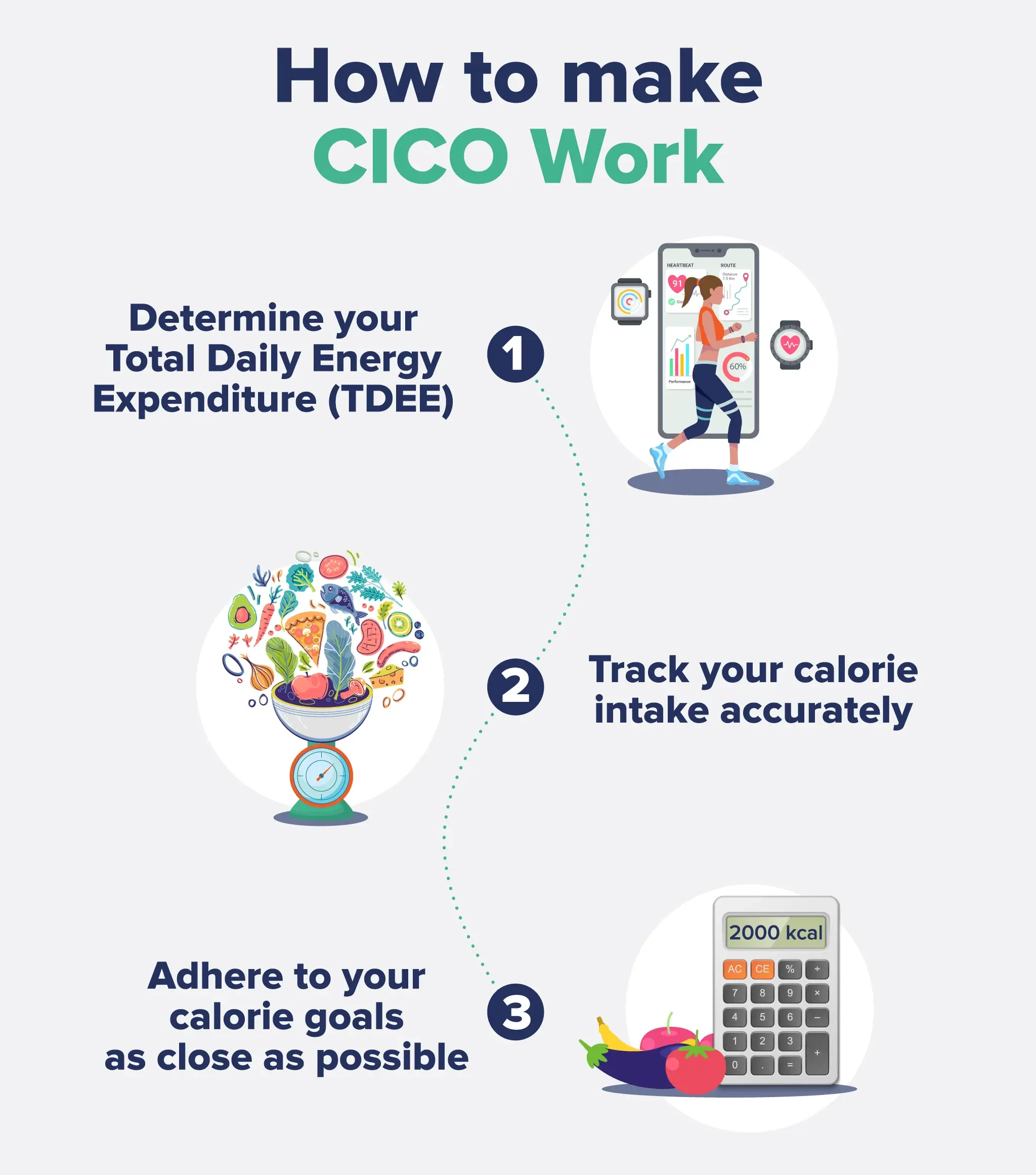Save $40 on your initial consult with a TNI Dietitian!
Talk to a real Dietitian for only $99: Schedule Now
This post contains links through which we may earn a small commission should you make a purchase from a brand. This in no way affects our ability to objectively critique the products and brands we review.
Evidence Based Research To fulfill our commitment to bringing our audience accurate and insightful content, our expert writers and medical reviewers rely on carefully curated research.
Read Our Editorial Policy
If you’re starting or about to start a weight loss journey, you’ve probably heard of the weight loss method called “calories in, calories out,” also known as CICO. But what is CICO?
In simple terms, CICO explains that we gain, maintain, or lose weight based on the calories we consume versus the calories we burn daily, also known as our Total Daily Energy Expenditure (TDEE).
Per the CICO rule, we will gain weight if we consume more calories than our TDEE. On the other hand, if we consume fewer calories than our TDEE, we will lose weight.
Simple, right? CICO offers a scientific explanation that simplifies the mystery that often surrounds weight loss. This is why CICO is one of the most popular dieting strategies.
While this weight loss strategy is relatively straightforward, there are some nuances that can be explored to further understand how to lose weight. Keep reading to learn more about how CICO works and some practical tips to help you successfully use it in your weight loss journey.

In a metabolically controlled environment—such as a clinical trial where calorie intake is controlled—a calorie deficit below a participant’s unique TDEE will result in weight loss.
However, we don’t live in research facilities where we’re provided with three perfectly portioned meals a day.
So, whether or not CICO “works” really comes down to 1) how you determine your TDEE, 2) accurately tracking your calorie intake, and 3) how closely you adhere to your calorie goals.
To find your TDEE, you can use any of the available calculators online. We like this one, which will give you a combination of your basal metabolic rate (BMR; the calories we burn at rest) and an estimation of the calories we burn through daily activities and exercise.
Your TDEE is your maintenance calories, or the number of calories you would need to consume to remain at your current weight.
Eating below your maintenance calories creates what is called a calorie deficit and will lead to weight loss.
Conversely, eating above your maintenance calories creates a calorie surplus and will lead to weight gain.
There is a slight caveat to this: your TDEE is not a static number and will fluctuate with your activity levels.
For example, suppose you frequently exercise but are suddenly sedentary for an extended period and continue to eat the same amount of calories. This may lead to unintentional weight gain.
The same can happen in the other direction. If you start walking 10,000 steps a day, you may feel hungrier than normal because you are burning more calories.
In general, if your activity levels remain the same each week, you can anticipate your TDEE will also.
Once you determine your TDEE, subtracting between 200 to 300 calories from that number will help find your calorie deficit if you want to lose weight. To gain weight, just add that number of calories instead.
This is an easy-to-moderate rate recommended for healthy weight loss or gain.
While you can increase your deficit or surplus by 400 or 500 calories, it’s not recommended unless done on the advice (or under the observation) of a medical professional.

If you’re specifically wondering how to do CICO, this is the section you’re looking for.
Since CICO focuses on calorie consumption, the key to making it work is accurately tracking your calories.
However, while CICO itself isn’t complicated, calorie tracking can be.
First, you will need a food-tracking app—such as MyFitnessPal, Cronometer, or MyNetDiary (my personal favorite)—and a food scale to accurately track your calories.
Once you’ve determined how many calories you should consume each day, your food tracker will probably also ask you to choose your macronutrient split.
This is the percentage of calories you will get from protein, carbohydrates, and fat.
Whether you’re trying to lose or gain weight, it’s typically recommended to prioritize protein before carbohydrates and fat.
Most apps will determine your split for you, which I recommend if you’re just getting started with calorie tracking. No need to overcomplicate things at this stage.
You can also customize your tracking apps if you’re more experienced with calorie tracking or want to prioritize a particular macronutrient.
Regardless of what split you set, know that if you go over or under a certain macronutrient within 50-100 calories of your target calorie budget, you’re doing fine.
When it comes to CICO, it is more important to stay within your calorie budget than worrying too much about your macronutrient split.
However, to follow the CICO diet successfully without feeling like you’re starving yourself, it is wise to prioritize your foods in the following order: protein > carbohydrates > fats.
This is because lean proteins, cruciferous vegetables, fruits, and whole grains will always contribute to better satiety (feeling fuller longer) and are typically more nutrient-dense foods.
On the other hand, though fats are beneficial for several bodily functions and are a necessary part of our diet, they are more calorically dense and have less volume, leading to lower satiety.
This is why we eat fattier foods like nuts, oils, and fatty meats in moderation when trying to lose weight.
Learning how to use a food scale is one of the handiest skills you can gain in any weight control journey.
Weighing food gives a much better idea of what real serving sizes look like compared to just eyeballing things.
This is especially helpful when weighing things like powders (such as protein powder or flour), grains, and liquids.
Eventually, you can ditch the food scale once you’ve got a good idea of what 100 grams of cottage cheese or 4 ounces of chicken looks like. Until then, the scale will help keep you on track!
The biggest mistake people make when starting to track their food is forgetting all the little extra ingredients like oils, sauces, and dressings.
These typically pack a caloric punch, so you don’t want to forget to track those, too!
The CICO rule’s flexibility allows for a wide range of food choices as long as you stay within your calorie limits.
So, technically, as long as you’re eating under your TDEE, you could only eat Twinkies and still lose weight.
In fact, a nutrition professor named Mark Haub did just that. For ten weeks, he ate mainly convenience store snacks while keeping his intake below 1800 calories a day.
Without any added exercise, he was able to lose a whopping 27 pounds!
While this demonstrates the effectiveness of calorie restriction for weight loss, there is a cautionary tale here… Professor Haub didn’t only eat snack cakes. He also supplemented his diet with milk, a protein shake, and one to two servings of fruits and vegetables.
That’s because protein and the nutrients we get from fresh fruit and veggies are vital to our health and for avoiding nutrient deficiencies.
So, no, CICO is not an excuse to eat highly processed foods to lose weight.
Losing weight in a healthy way requires a good diet quality that includes healthy fats, lean protein, and whole grains.
Like any dieting strategy, there are pros and cons to following the CICO rule:
Yes, CICO is an effective method for weight loss because it is based on this fundamental principle: eat fewer calories than you burn. By maintaining a calorie deficit, you can lose weight regardless of the types of foods you eat, though a balanced diet is recommended for overall health.
The key difference between the keto diet and CICO lies in the approaches to weight loss. The keto diet focuses on reducing carbohydrate intake to a very low level, forcing the body to enter a state of ketosis and burn fat for fuel. In contrast, CICO requires you to count calories—without restricting specific macronutrients—to achieve weight loss. Additionally, the keto diet is much more restrictive, whereas CICO allows for more flexibility as long as calorie goals are met.
Calories in; calories out.
Though it might be called the “CICO diet” in other places on the internet, CICO is so simple and unrestrictive that you can’t call it a diet as much as it is a lifestyle strategy.